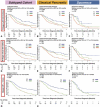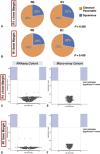The Impact of Molecular Subtyping on Pathological Staging of Pancreatic Cancer
- PMID: 36745763
- PMCID: PMC9831035
- DOI: 10.1097/SLA.0000000000005050
The Impact of Molecular Subtyping on Pathological Staging of Pancreatic Cancer
Abstract
Background: The long-term outcomes following surgical resection for pancreatic ductal adenocarcinoma (PDAC) remains poor, with only 20% of patients surviving 5 years after pancreatectomy. Patient selection for surgery remains suboptimal largely due to the absence of consideration of aggressive tumor biology.
Objective: The aim of this study was to evaluate traditional staging criteria for PDAC in the setting of molecular subtypes.
Methods: Clinicopathological data were obtained for 5 independent cohorts of consecutive unselected patients, totaling n = 1298, including n = 442 that underwent molecular subtyping. The main outcome measure was disease-specific survival following surgical resection for PDAC stratified according to the American Joint Commission for Cancer (TNM) staging criteria, margin status, and molecular subtype.
Results: TNM staging criteria and margin status confers prognostic value only in tumors with classical pancreatic subtype. Patients with tumors that are of squamous subtype, have a poor outcome irrespective of favorable traditional pathological staging [hazard ratio (HR) 1.54, 95% confidence interval (CI) 1.04-2.28, P = 0.032]. Margin status has no impact on survival in the squamous subtype (16.0 vs 12.1 months, P = 0.374). There were no differences in molecular subtype or gene expression of tumors with positive resection margin status.
Conclusions: Aggressive tumor biology as measured by molecular subtype predicts poor outcome following pancreatectomy for PDAC and should be utilized to inform patient selection for surgery.
Copyright © 2021 The Author(s). Published by Wolters Kluwer Health, Inc.
Conflict of interest statement
The authors report no conflicts of interest.
Figures



References
-
- Siegel RL, Miller KD, Jemal Α.. Cancer statistics, 2018. CA Cancer J Clin. 2018;68:7–30. - PubMed
-
- Rahib L, Smith BD, Aizenberg R, et al. . Projecting cancer incidence and deaths to 2030: the unexpected burden of thyroid, liver, and pancreas cancers in the United States. Cancer Res. 2014;74:2913–2921. - PubMed
-
- Collisson EA, Bailey P, Chang DK, et al. . Molecular subtypes of pancreatic cancer. Nat Rev Gastroenterol Hepatol. 2019;16:207–220. - PubMed
-
- Bailey P, Chang DK, Nones K, et al. . Genomic analyses identify molecular subtypes of pancreatic cancer. Nature. 2016;531:47–52. - PubMed
Publication types
MeSH terms
Grants and funding
LinkOut - more resources
Full Text Sources
Medical

